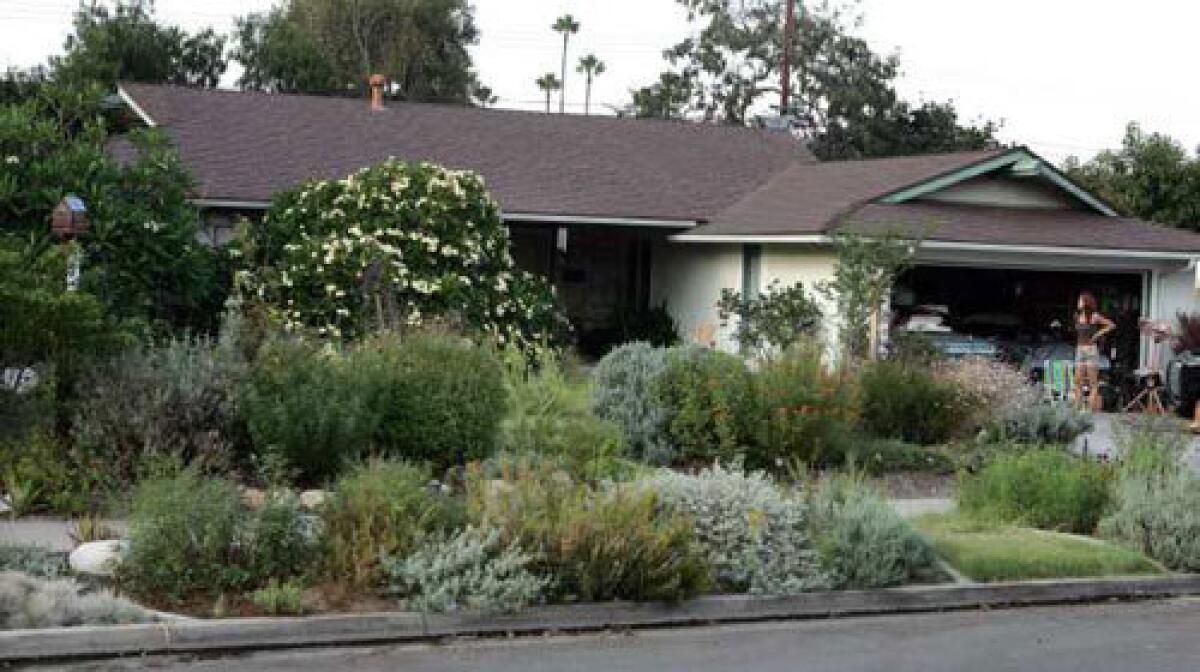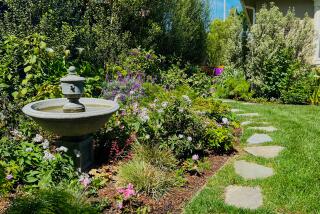Grieving over a garden: Moving away from your home garden can be difficult

Wanda Teays calls it “gardening grief”: the experience of saying goodbye to a landscape you’ve tended with loving care, a landscape to which you’ve become so emotionally attached, you can’t help but go back and see how new owners have maintained it -- or not.
“If you’ve put years into a garden and watched plants grow from a tiny seed or a small plant into a three-story tree, your sense of grieving will be great,” said Teays, chairwoman of the philosophy department at Mount St. Mary’s College in Los Angeles and an avid gardener. “It’s a form of separation anxiety.”
Leaving a house can be difficult, but leaving behind a garden can be downright traumatic. For some, puttering in the yard is more than a weekend hobby. It’s therapy and creative self-expression. It’s memories of toddlers searching for Easter eggs or the scent of a mimosa tree wafting into the bedroom. It’s the taste of a freshly picked plum, the sound of the wind blowing through the eucalyptus trees, the feeling of lamb’s ear brushing against a cheek.
So it’s no wonder that when Carolyn Smuts and her husband, Eric, were digging up two guava trees from their Huntington Beach front yard, they noticed a couple watching closely from a nearby car. The suspicious-looking observers turned out to be the former owners, who were horrified to see the uprooting of trees they had planted. They finally spoke up and ultimately carted off the two guavas and three palm trees to their new home.
Others cope with gardening grief by trying to select a buyer or renter who cherishes the landscaping and plans to maintain or improve it. Ina Hillebrandt of Brentwood once lived on a 2-acre property in Connecticut. As she prepared to move, she jokingly told the real estate agent that she wouldn’t sell unless the buyer agreed to take care of the plants.
“She took me seriously,” Hillebrandt said. The new homeowner did make the promise but was unable to deliver. Five years after selling, Hillebrandt visited Connecticut and knocked at the door of her former house. The embarrassed new owner immediately apologized: “The plants aren’t as healthy as when you left.”
Some homeowners leave detailed instructions when they sell. Debbie Swanson Patrick’s English cottage home in Altadena came with a set of documents including an outline of the design, names of plants and details on their care when she purchased the home from the Ellis family 13 years ago. Miriam Ellis said she was most concerned about a fledgling crape myrtle she and her husband planted.
“I wanted to make sure that it would continue to grow,” she said.
Ellis, who now lives in La Cañada Flintridge, admits to the most common coping mechanism: the drive-by. Ellis last checked on Patrick’s home about six months ago when she was in Altadena. She was pleased to see that everything “looks pretty much the same. Even the little treehouse my husband built is still there.”
Nora Lee recalls her family planting an Italian cypress tree at their former Pasadena home when her son was 2 years old. She does frequent drive-bys to check the tree’s progress and reports that both son and tree have grown “straight and tall.” The tree now dwarfs her son, who is 18 years old and more than 6 feet tall.
“I’m always crossing my fingers that it hasn’t been removed,” Lee said.
Barbara Koenig, an Altadena landscape architect, avoids that anxiety by moving plants with her -- everything from a day lily to a palmetto tree. But for every satisfying solution, you’ll hear a cautionary tale, such as the one about a family dog buried under a tree in the backyard -- and new owners who replaced the tree with an in-ground pool.
Koenig recalls her first home in Monroe, Ga. She and her husband, Brad, planted a magnolia tree that grew to provide much-needed shade to the back of the house. Years later, when Koenig and her husband did a drive-by, they saw that the magnolia -- and the entire woodland area in the backyard -- were gone.
“I don’t know why they did it,” Koenig said. “Those woods were a visual and a noise buffer.”
Two years ago the couple revisited their former home in Savannah, Ga., and discovered that new owners had paved over every trace of green in the side yard.
Such tales sum up why Teays cautions against visiting a former residence.
“There’s a Buddhist warning about too much attachment,” said Teays, whose Silver Lake house has a lush English garden. “If you choose to leave a house, you have to let go. You can’t go home again, and you certainly can’t go back to the same garden again.”
Even if the new homeowners keep the same plans and plants, they may not live up to your expectations. Teays advises gardeners to look at their new gardens, whether smaller or larger, as an opportunity to take risks and create something entirely different.
Marguerite Marsh, a psychotherapist and a gardener, often helps her clients through the letting-go process. She said that the trick is to look beyond the loss. She and her husband plan to move from their third-fourths-acre yard in La Cañada Flintridge to a penthouse in Pasadena.
“I’ll be letting go of high water bills and high maintenance bills,” she said, “and setting forth on a whole new adventure.”
More to Read
Sign up for our L.A. Times Plants newsletter
At the start of each month, get a roundup of upcoming plant-related activities and events in Southern California, along with links to tips and articles you may have missed.
You may occasionally receive promotional content from the Los Angeles Times.






